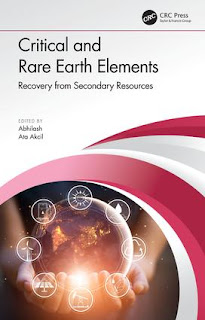Chapter 5.
Ugur Ulusoy
Raw materials are significant to global economy and development, as well as
for sustaining and improving our quality of life. Therefore, ensuring
authentic, sustainable, and unaltered access of raw materials is of increasing
global concern. Cobalt is an essential metal for the production of rechargeable
batteries and superalloys and has been deemed as a critical raw material due to
its scarcity, production, and supply chain reliability by both US Department of
Energy (DOE) and European Union (EU) in 2010 and 2011, respectively. It has
been reported that, by 2030, the cobalt demand for emerging technologies such
as lithium-ion batteries and synthetic fuels would be a double of the 2006
level. Total cobalt mine production globally was 1.1 × 105 kg
in 2017, with major production from Democratic Republic of Congo (DRC), Russia,
and China. Cobalt has a substitutability index of 0.71 and end-of-life
recycling input rate of 16%. Cobalt present in purchased scraps represents an
estimated 33% of reported cobalt consumption. Therefore, cobalt recovery from
secondary resources is beneficial from both environmental and economical
viewpoints due to decreasing wastes and increasing energy efficiency as well as
resource productivity. This chapter reviews cobalt recovery processes from
secondary resources, including sludge generated in nickel refinery, low-grade
waste solution from copper open pit mine, zinc smelting waste/by-products,
flotation tailings, cobalt-bearing alloy scrap, spent materials such as
battery, cemented carbide, and catalysts.
Please
cite this work as;
"Ugur Ulusoy, 2019, Critical and Rare Earth Elements:
Recovery from Secondary Resources, Edited by Abhilash and Ata Akcil. Chapter 5, “Review of the Recovery of Cobalt from Secondary Resources”
pp. 115-153, ISBN 978-0-367-08647-3, CRC Press/Taylor and Francis Group, New York."


Comments